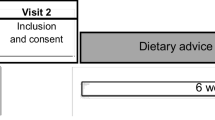Abstract
Introduction and hypothesis
The objective was to perform a systematic review of the literature to examine original research on the role of diet in fecal incontinence (FI) with a dual focus on dietary differences in FI and dietary treatments for FI.
Methods
We searched the PubMed and Embase databases for any peer-reviewed original research in English on the role of diet in FI.
Results
We identified 172 unique citations. After title review and exclusion of articles not reporting original research, 9 publications were included in the final review: 4 focused on dietary differences and 5 focused on dietary treatments for FI. Limited evidence indicates that macro- and micronutrient intake does not differ significantly in those with and without FI. However, certain foods were perceived to improve or exacerbate FI symptoms and these varied and were adjusted as part of self-care practices. A high-fiber diet may reduce incontinence frequency.
Conclusions
Data on the pathogenesis of FI from a dietary perspective are scant. Based on the limited data, dietary differences between those with and without FI provide little insight with the exception of fiber. Further studies are needed to elucidate treatments for FI using fiber and dietary modifications.

Similar content being viewed by others
References
Haylen BT, de Ridder D, Freeman RM, Swift SE, Berghmans B, Lee J, Monga A, Petri E, Rizk DE, Sand PK, Schaer GN (2010) An International Urogynecological Association (IUGA)/International Continence Society (ICS) joint report on the terminology for female pelvic floor dysfunction. Int Urogynecol J 21(1):5–26. doi:10.1007/s00192-009-0976-9
Bharucha AE, Dunivan G, Goode PS et al (2015) Epidemiology, pathophysiology, and classification of fecal incontinence: state of the science summary for the National Institute of Diabetes and Digestive and Kidney Diseases (NIDDK) workshop. Am J Gastroenterol 110(1):127–136
Norton NJ (2004) The perspective of the patient. Gastroenterology 126 [1 Suppl 1]:S175–S179
Shah BJ, Chokhavatia S, Rose S (2012) Fecal incontinence in the elderly. Am J Gastroenterol 107(11):1635–1646
Bharucha AE, Zinsmeister AR, Locke GR et al (2006) Risk factors for fecal incontinence: a population-based study in women. Am J Gastroenterol 101:1305–1312
Bharucha AE, Zinsmeister AR, Schleck CD, Melton LJ 3rd (2010) Bowel disturbances are the most important risk factors for late onset fecal incontinence: a population-based case–control study in women. Gastroenterology 139(5):1559–1566
Whitehead WE, Borrud L, Goode PS et al (2009) Fecal incontinence in US adults: epidemiology and risk factors. Gastroenterology 137(2):512–517
Markland AD, Goode PS, Burgio KL et al (2010) Incidence and risk factors for fecal incontinence in black and white older adults: a population-based study. J Am Geriatr Soc 58:1341–1346
Goode PS, Burgio KL, Halli AD et al (2005) Prevalence and correlates of fecal incontinence in community-dwelling older adults. J Am Geriatr Soc 53(4):629–635
Bliss DZ, Fischer LR, Savik K (2005) Managing fecal incontinence: self-care practices of older adults. J Gerontol Nurs 31(7):35–44
Whitehead WE, Wald A, Norton NJ (2001) Treatment options for fecal incontinence. Dis Colon Rectum 44:131–142
Bliss DZ, Jung HJ, Savik K, Lowry A, LeMoine M, Jensen L, Werner C, Shaffer K (2001) Supplementation with dietary fiber improves fecal incontinence. Nurs Res 50(4):203–213
Bliss DZ, Savik K, Jung HJ, Whitebird R, Lowry A, Sheng X (2014) Dietary fiber supplementation for fecal incontinence: a randomized clinical trial. Res Nurs Health 37(5):367–378. doi:10.1002/nur.21616
Hansen JL, Bliss DZ, Peden-McAlpine C (2006) Diet strategies used by women to manage fecal incontinence. J Wound Ostomy Continence Nurs 33(1):52–61; discussion 61–62
Moher D, Liberati A, Tetzlaff J, Altman DG, The PRISMA Group (2009) Preferred reporting items for systematic reviews and meta-analyses: the PRISMA statement. PLoS Med 6(6):e1000097. doi:10.1371/journal.pmed1000097
Patterson RE, Kristal AR, Tinker LF, Carter RA, Bolton MP, Agurs-Collins T (1999) Measurement characteristics of the women's health initiative food frequency questionnaire. Ann Epidemiol 9(3):178–187
Markland AD, Richter HE, Burgio KL, Bragg C, Hernandez AL, Subak LL (2009) Fecal incontinence in obese women with urinary incontinence: prevalence and role of dietary fiber intake. Am J Obstet Gynecol 200(5):566.e1–566.e6. doi:10.1016/j.ajog.2008.11.019
Bliss DZ, McLaughlin J, Jung HJ, Lowry A, Savik K, Jensen L (2000) Comparison of the nutritional composition of diets of persons with fecal incontinence and that of age- and gender-matched controls. J Wound Ostomy Continence Nurs 27(2):90–91; discussion 93–97
Croswell E, Bliss DZ, Savik K (2010) Diet and eating pattern modifications used by community-living adults to manage their fecal incontinence. J Wound Ostomy Continence Nurs 37(6):677–682. doi:10.1097/WON.0b013e3181feb017
Lauti M, Scott D, Thompson-Fawcett MW (2008) Fibre supplementation in addition to loperamide for faecal incontinence in adults: a randomized trial. Colorectal Dis 10:553–562. doi:10.1111/j.1463-1318.2007.01439.x
Schnelle JF, Leung FW, Rao SS, Beuscher L, Keeler E, Clift JW, Simmons S (2010) A controlled trial of an intervention to improve urinary and fecal incontinence and constipation. J Am Geriatr Soc 58(8):1504–1511. doi:10.1111/j.1532-5415.2010.02978.x
Markland AD, Burgio KL, Whitehead WE, Richter HE, Wilcox CM, Redden DT, Beasley TM, Goode PS (2015) Loperamide versus psyllium fiber for treatment of fecal incontinence: the Fecal Incontinence Prescription (Rx) Management (FIRM) randomized clinical trial. Dis Colon Rectum 58(10):983–993. doi:10.1097/DCR.0000000000000442
McGill CR, Fulgoni VL III, Devareddy L (2015) Ten-year trends in fiber and whole grain intakes and food sources for the United States population: National Health and Nutrition Examination Survey 2001–2010. Nutrients 7(2):1119–1130. doi:10.3390/nu7021119
US Department of Health and Human Services; US Department of Agriculture. 2015–2020 Dietary Guidelines for Americans. 8th edn. US Dept of Health and Human Services, Washington, DC http://www.health.gov/DietaryGuidelines. Accessed 15 January 2016
Conlon MA, Bird AR (2014) The impact of diet and lifestyle on gut microbiota and human health. Nutrients 7(1):17–44. doi:10.3390/nu7010017
Koloski NA, Jones M, Wai R, Gill RS, Byles J, Talley NJ (2013) Impact of persistent constipation on health-related quality of life and mortality in older community-dwelling women. Am J Gastroenterol 108(7):1152–1158. doi:10.1038/ajg.2013.137
Author information
Authors and Affiliations
Corresponding author
Ethics declarations
Funding
None.
Conflicts of interest
None.
Grants
U.U. Andy has received research grants from Pelvalon, Inc.
Rights and permissions
About this article
Cite this article
Colavita, K., Andy, U.U. Role of diet in fecal incontinence: a systematic review of the literature. Int Urogynecol J 27, 1805–1810 (2016). https://doi.org/10.1007/s00192-016-2979-7
Received:
Accepted:
Published:
Issue Date:
DOI: https://doi.org/10.1007/s00192-016-2979-7




